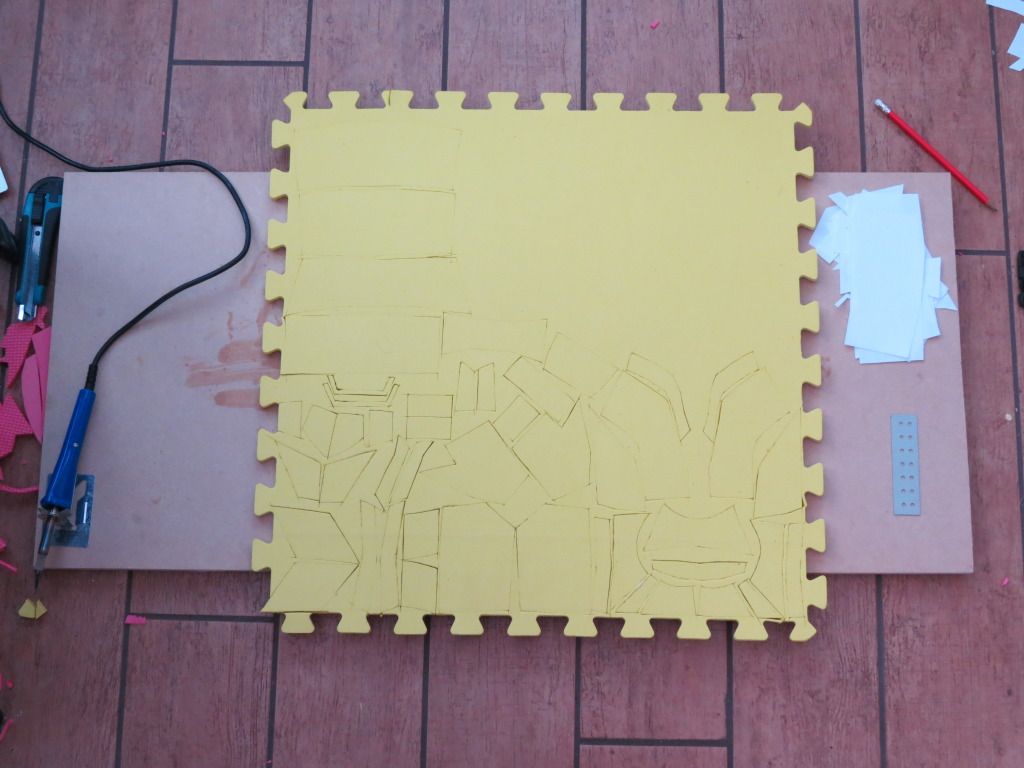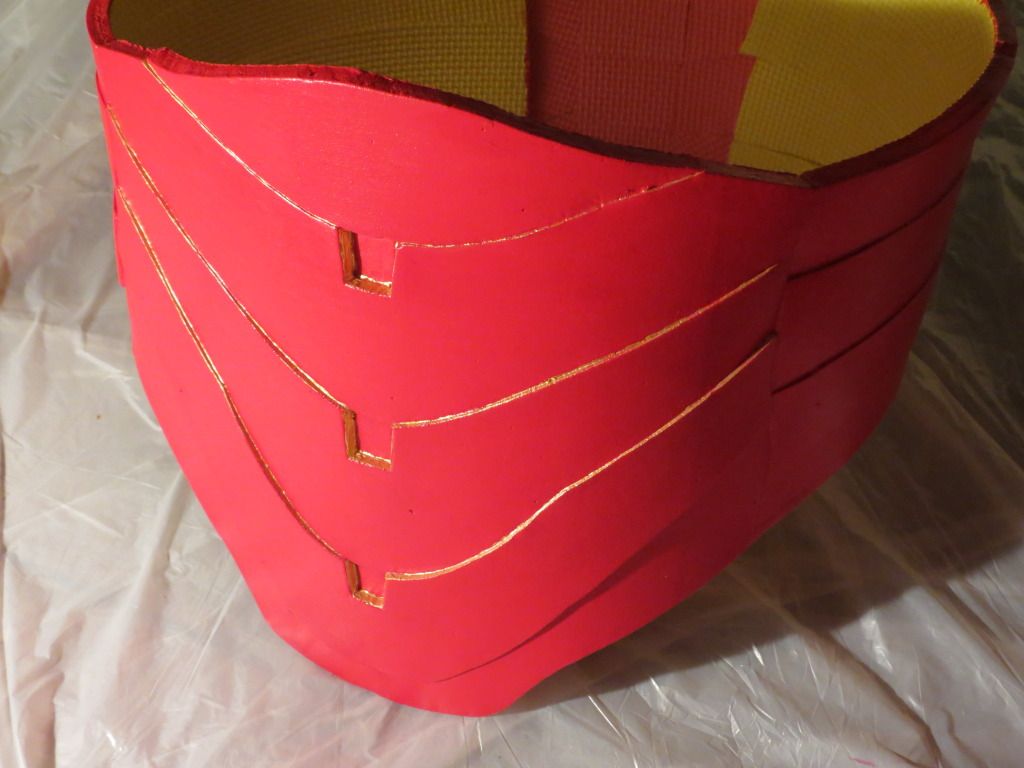I thought about this way back in March or so, and started work on a test piece, to see how it might work out.. There were plenty of people discussing it over in the forums, but the main approach used fiberglass & resin, & required care not to poison yourself with fumes / dust.. I wasn't so keen on that part, as most of my work is done in an indoor living space.
I tried an alternate approach to strengthening.. with reasonable results, then found an approach using high density foam flooring tiles.. these just needed cutting, glueing, and painting.. surely I could do that.. right ? ;p
Well.. it's now October, and I'm done.. the build took around 3 months worth of weekends, with it getting quite busy toward the end, working most evenings as well.. I suspect starting a month earlier would have been a better idea ;p
So.. Here's the final result..
And now.. here's how it got to this stage..
Step 1 - Templates, printing, cutting..
 |
| Templates on foam tile. |
 |
| Hot Knife of Doom |
Which you then carefully cut around like this.. I'm using a hot knife to do this, which works out a LOT easier than swapping blades repeatedly as they go blunt.
 |
| Parts sliced out inside tile. |
Eventually, after much effort, you end up with your cutting board covered in tiny little foam tile pieces.. these are the parts just for the brace (the sort of undershirt bit, with the rear neck support).
 |
| Parts ready to assemble. |
It helps a lot if you cut the pieces with the angles you will need to assemble them with.. cutting new angles later is tricky, as the foam has a tendency not to cut well for very small cuts.
Step 2 - Assembly
 |
| Various Glues! |
So I went for super glue.. here are a variety of superglues from pound land.. only 1 pound each pack!
 |
| Used Glues! and Gloves! |
Super glue is great though, apart from its amazing ability to immediately stick to your skin. I found I could buy cheap packs of vinyl gloves, which at least meant I only stuck those together.
If you do use gloves, be aware eventually you'll stick the gloves to the foam, tear the gloves, then glue the torn gloves to your fingertips ;p
 |
| Back of brace |
For continuity, here's (left) the brace that was cut out, after assembly. Looks much less like an oddball 3d jigsaw =)
Right shows the two arm pieces almost fully assembled. The final tubes for the wrists are not fixed in position yet, and the joints are not linked.
 |
| Arms assembled |
Finally, here's the back piece, and corresponding front piece, before they are joined together..
Also showing the alignment for the arc reactor tube, as it runs through both parts.
 |
| Back assembled. |
 |
| Front assembled, alignment ok. |
Step 3 - Priming
 |
| Painting with milk!! |
(The generic white glue that may or may not be called 'Elmers' glue elsewhere.. here I'll stick with PVA, the stuff you can get in bulk from a DIY shop).
 |
| Milky! |
Mix the PVA 50:50 with water, stir until you get a milk-like result with no bits.. then paint on in a thin layer.. then repaint then repaint then repaint.. the first 5 or so coats will seem to make no difference, but around coat 8 or so, it'll start looking a bit smoother, I used around 10 coats.. let each coat dry properly say an hour or so on a warm day.
Step 4 - Painting & Varnishing
 |
| Crafty Acrylic Paints |
However, it also dries real fast, leaves brush marks, I found the best way to apply it was by diluting it about 60:40 paint:water and applying it with a foam brush.
 |
| Painting corner |
 |
| More paintings.. |
So here are a bunch more pictures of my small painting area
 |
| Painting the main chest part |
 |
| Basic red / gold on arms |
Lots of painting =)
For thick paint, wedges of foam tile can be sliced and used as improvised foam brushes, painting with the neat paint.. for real fine detail work, I used some older water color paint-by-numbers brushes to do edge work etc. The gold lines on this part were real killers to get right =)
 |
| Fine detail gold work on abs |
Finally, once it's all painted, it needs a coat of glossy varnish.. apparently regular varnish just won't end well on foam. Once the foam flexes, the varnish cracks & bad stuff happens. The collective wisdom of the foam builders online via google suggests that you can get awesome flexible clear coat, but that stuff doesnt come in cheap, and hey, this is just a Halloween costume, not a show piece.
A bit more searching reveals an alternative.. Pledge Future, except that got withdrawn in the UK and replaced with new super Pledge Klear, which is full of shocking reviews on amazon of people who had to strip their floors after using it. Still there were a few reports from armor makers / model makers who said it worked pretty much the same as the old version.. so I figured it was worth a shot.
 |
| Arms & Mask all glossed. |
I carefully tested this stuff while doing the painting, all my test samples came out great, even if I mistreated them, over flexed them, etc.
Great, so I set out to coat the entire lot with it, knowing I'd done nice tests.. applied it to every piece, came back in 20 mins, and .. disaster, every part dried with milky patches & streaks.. argh.
 |
| Chest & Back all glossed |
Figuring I'd either have to wipe it all off, or repaint it all I went with trying to wipe it off, using a little neat polish as a solvent on a piece of kitchen towel, I scrubbed gently.. and removed the milky finish.. and also noticed that the rag I was using was leaving behind a very very thin coat of polish, that seemed to be drying very fast, and importantly, drying clear (klear?).
So I worked back through every part, removing the 1st attempt and recoating with an almost instant drying thin coat, applied with just a kitchen towel 'damp but not dripping' with it.
Eventually after 15+ coats, it also started to look glossy.. which took more than a while to apply to the entire costume. But seems well worth it =)
In the next post I'll get into some of the details of some of the hidden parts and details that went into the rest of the construction, including..
- Modded Arc Reactor.
- Mirrored Lenses in the Helmet.
- Shaping Wires for Shoulder & Facemask.
- Articulation for the Arm Joints.
- Lining/edging for Helmet & Chest Section.
- Buckles/Fastenings for the Arms & Shoulders.

No comments:
Post a Comment